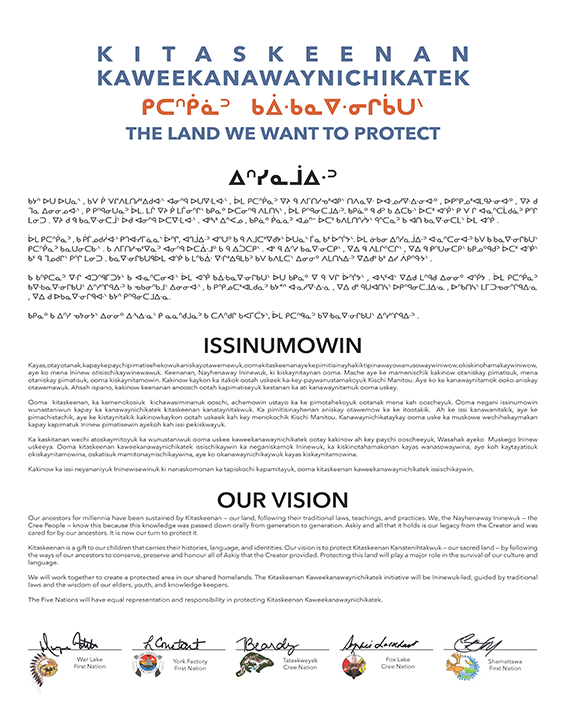Vision Overview
Visioning is something that we all must work together on. Once we have our vision together, that will be our guide for the rest of this project.
This project was guided by our Elders to ensure that preparing our vision (signed statement & document) was not rushed. Over two years were spent having conversations with members (of the five Nations) of all ages about their vision for Kitaskeenan Kaweekanawaynichikatek - Our Land We Want to Protect. Many quotes were recorded and documented. The quotes we were able to obtain permission for are featured in this first edition of the Vision Document. We will continue to learn from members of the five Cree (Nayhenaway lninewuk) Nations as we move forward in protecting our shared ancestral lands.
Our Vision
Our ancestors for millennia have been sustained by Kitaskeenan - our land, following their traditional laws, teachings, and practices. We, the Nayhenaway lninewuk - the Cree People - know this because this knowledge was passed down orally from generation to generation. Askiy and all that it holds is our legacy from the Creator and was cared for by our ancestors. It is now our turn to protect it.
Kitaskeenan is a gift to our children that carries their histories, language, and identities. Our vision is to protect Kitaskeenan Kanatenihtakwuk - our sacred land - by following the ways of our ancestors to conserve, preserve and honor all of Askiy that the Creator provided. Protecting this land will play a major role in the survival of our culture and language.
We will work together to create a protected area in our shared homelands. The Kitaskeenan Kaweekanawaynichikatek initiative will be lninewuk-led, guided by traditional laws and the wisdom of our elders, youth, and knowledge keepers.
The Five Nations will have equal representation and responsibility in protecting Kitaskeenan Kaweekanawaynichikatek.
Visioning refers to how we see these lands being protected, being used, and how we will preserve our history. We know it’s where our people lived, and where our families had homes. Our people had relationships to the land, having lived there long ago.

